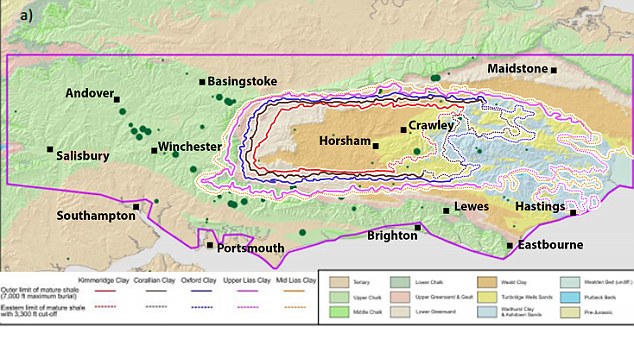Summary
- New British Geological Survey (BGS) Report
- 4.4 billion barrels of shale oil under South East
- But only very small percentage can be exploited
- Typical 4% would mean 176 million barrels
- Only 4 months of present UK oil consumption
- Would require 1,400 wells drilled to extract
- Even 10% would only be 10 months of oil
- Would require 3,500 wells drilled to extract
- Despite this massive push to exploit it likely
- Desperate scramble to profit from last oil in UK
- Kimmeridge Clay said to contain most shale oil
- Similar to the Bakken Shale in North Dakota
- Toxic nightmare threatens Sussex and Kent
- Communities are getting organised to resist

Shale Formations In Central Weald (Sussex & Kent) Identified By The BGS Report As Containing Oil (Click To Enlarge)
The carefully timed announcement of a claimed 4.4 billion barrels of shale oil under southern England, while likely filled with hot air, does put a little more detail on the threat we face. As with the previous announcement last June of vast quantities of shale gas under northern England this is “oil-in-place” and only provides hints at the much smaller fraction which is technically recoverable.
The difficulties involved in scrapping the bottom of the fossil fuel barrel mean that only a small percentage of these unconventional resources can be extracted. A recovery factor of 4 percent (or potentially much less) is typical from experience in the US, though values of 10 percent or more are often hyped. For a 4 percent factor the BGS estimate would mean 176 million barrels (only 4 months of UK consumption).
While this might make it seem small, the amount of effort involved means the impacts are not. An above average shale oil well in the US only produces around 125,000 barrels of oil (PDF – page 7) and so at least 1,400 wells would be needed to extract 176 million barrels. If the higher 10 percent recovery factors hyped by the industry were possible, at least 3,500 wells would be needed to extract the 440 million barrels of oil.

Shale Oil Well Pads Stretching Into The Distance In The Bakken Shale, North Dakota (Click To Enlarge)
In comparison, the UK sector of the North Sea has produced around 30 billion barrels of oil to-date, with remaining proven reserves of 3.1 billion barrels, but this has involved drilling 10,000 wells, over a third of which are already leaking. Onshore (at least in terms of the pads if not the oil) the largest oil field by a long way, Wytch Farm near Poole in Dorset, has produced about 500 million barrels from 75 wells.
North Sea oil has only really lasted a couple of decades, between ramping-up production in 1980 and going into decline around 2000. This new ‘boom’ can at most last a handful of years given the amount of oil that is recoverable and the fact that shale oil wells can decline by 70 percent in just their first year of production. At its best (from the frackers perspective) this would be less oil than Wytch Farm but requiring 50 times as many wells to be drilled to extract it.
However, given the current system’s unsustainable addiction to fossil fuels it should not be assumed that massive effort will not be expended to exploit even this small amount of oil. In the world of extreme energy desperation is the name of the game and the bottom of every barrel must be scrapped dry. Even 176 million barrels of oil would fetch almost £20 billion at today’s prices, and there plenty of corporations lining up to get a cut of the profits.
Around half (2.03 billion barrels) of the claimed oil in the British Geological Survey (BGS) report is attributed to the Kimmeridge Clay shale layer, the shallowest (1,830-3,695 feet at Balcombe) of the several shale layers in the Weald. The report notes that “low porosity and low permeability micrites may be targets in a hybrid Bakken-type shale play, with shale units above and below”, the same micrite layers recently targeted by Cuadrilla at Balcombe.
The Bakken Shale in North Dakota (as well as the Eagle Ford Shale in Texas) is the place to look to see what this sort of fracking means. Drilling 4 wells per square mile with 1.8 mile (2.9 km) horizontals, fractured in 40 stages along their length, is now becoming standard in the Bakken. As with shale gas in other parts of the US, this results in a host of severe impacts including water contamination, air pollution, massive amounts of toxic/radioactive waste and carnage on the roads from the massive amounts of truck traffic.
Vast swathes of countryside across Sussex and Kent face industrialisation so that a small number of corporations can profit. As we have seen already in Balcombe affected communities are getting organised to resist this threat. They understand that they would have to live with the toxic legacy of fracking long after these corporations have gone bust. Across the globe organised communities are successfully resisting these threats and with over 130 anti-fracking groups in the UK, and growing fast, this battle is just beginning.


